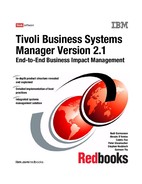
Chapter 12. Automatic Business System View creation 403
12.2 ABS usage example
In this section, we show an example of building an ABS configuration file for the
scenario to make a business system view hierarchy as shown in Figure 12-2.
Figure 12-2 Sample business system view
The Operating Systems business system view has to contain all of the production
operating systems that in our naming convention begin with SC and M. The DB2
Subsystems BSV has to contain all the production DB2 subsystems with the
name not starting with DB.
Let’s create the configuration file.
12.2.1 Manual creation of the business system view
The OS resources can be grouped into a list we call OPER_SYS and assigned
with the operands S% and M% that match the double naming convention we
have established. The DB2 resources do not have to be grouped into a list
because only the naming convention DB% has to be matched so a line in the
ListName column would be useless. The PatternList section is in Example 12-2.
Example 12-2 PatternList section
Pattern List
ListName Operand
OPER_SYS S%
OPER_SYS M%
The resources we want to filter are the OS class and the D2SS class. The
attribute of the class on which we want to perform the test is Name. The
operators LIKE LIST and NOT LIKE are performed on the resource’s class
attribute to identify the resources we are interested in. The Pattern section is in
Example 12-3 on page 404.
ITSO Resources
Operating Systems
DB2 Subsystems
Dynamic OSes
Start with SC* or M*
Dynamic D2SS
Not start with DB

404 Tivoli Business Systems Manager Version 2.1: End-to-End Business Impact Management
Example 12-3 Pattern section
Pattern
Pattern Class Attribute When Operator Operand1 Operand2
1 OS name Current LIKE LIST OPER_SYS %
2 DB2 name Current NOT LIKE DB% %
The preceding patterns do not have to be evaluated together. The OS and DB2
resources do not have any common relationships. We have to write different
groups of criteria for the two patterns. The CriteriaToPattern section is in
Example 12-4.
Example 12-4 CriteriaToPattern section
CriteriaToPattern
Criteria Pattern PatternRelated
1001 1 1
1002 2 2
The business system view hierarchy we want to create is formalized in the Path
section as shown in Example 12-5.
Example 12-5 Path section
Path
Path Level Name
PROD_OS 1 ITSO RESOURCES
PROD_OS 2 Production OS
PROD_OS 3
PROD_DB2 1 ITSO RESOURCES
PROD_DB2 2 Production DB2
PROD_DB2 3
We want create the resources in the BSV with their name and a new description.
The section CriteriaToPath is shown in Example 12-6.
Example 12-6 CriteriaToPath section
CriteriaToPath
Criteria Path Level Pattern Variable Value
1001 PROD_OS 3 1 name <1:name>
1001 PROD_OS 3 1 Desc Production_OS
1002 PROD_DB2 3 2 name <2:name>
1002 PROD_DB2 3 2 Desc Production_DB2

Chapter 12. Automatic Business System View creation 405
CriteriaToPath is the last section of our configuration file. For example, if the
whole configuration file is called BSVcurrent.txt we load it in the datatabase using
the command:
sh absconfig.ksh -Sibmtiv5 -Usa -PXXXX -iBSVcurrent.txt
The data is processed and inserted in the database. The tables filled with the
ABS data are alobFilePatterList, alobFilePattern, alobFileCriteriaToPattern,
alobFilePath, and alobFileCriteriaToPath. Figure 12-3 shows those tables and
their entries resulting from our example.
Figure 12-3 Database tables with the loaded ABS configuration

406 Tivoli Business Systems Manager Version 2.1: End-to-End Business Impact Management
The ABS engine is now ready to add the BSVs dynamically when a new resource
is discovered or an attribute of the monitored resources is updated or changes.
The resources already present in the All Resources View have to be processed
to make them appear in the BSVs. The command absTest.ksh is used to test the
configuration and to discover the Business Systems by using the command
discovery and queuing options. For a detailed description of the absTest.ksh
syntax see the
IBM Tivoli Business Systems Manager: Administrator’s Guide
,
GC32-0799 on page 461. The BSVs discovered by the absTest.ksh command
are queued into the alobQueueCreateLob and ev_auto_create_object_param
tables. They can be created by running the ABS Create Process job manually or
executing the SQL EXECUTE alobProcessQueueCreateLob from the Query
Analyzer window. The result of our example is shown in Figure 12-4.
Figure 12-4 ITSO RESOURCES business system view
Chapter 12. Automatic Business System View creation 407
12.2.2 BSV creation tool
As you may have noticed, the effort to create the business system view definition
for a simple BSV structure is cumbersome. We developed a Java-based tool in
our lab to create the BSV structure using a graphical interface, and we used it to
produce some of our definitions. This quick-and-dirty tool has some limitations:
? It does not cover all possibilities and combinations that can be derived by
editing the configuration file manually.
? It does not support mapping of attributes in the CriteriaToPath section; it
simply puts the mapping of the name into itself in that section. This is mostly
adequate for the majority of cases.
? It does not have extensive error-checking for the operand against the
operator.
You can get the tool from the additional material that accompanies this book as
described in Appendix D, “Additional material” on page 577.
To use the tool, extract the class and attribute definition from the IBM Tivoli
Business Systems Manager database using:
absAllowedClassAttribute.ksh -oclassattr.txt
..................Content has been hidden....................
You can't read the all page of ebook, please click here login for view all page.
